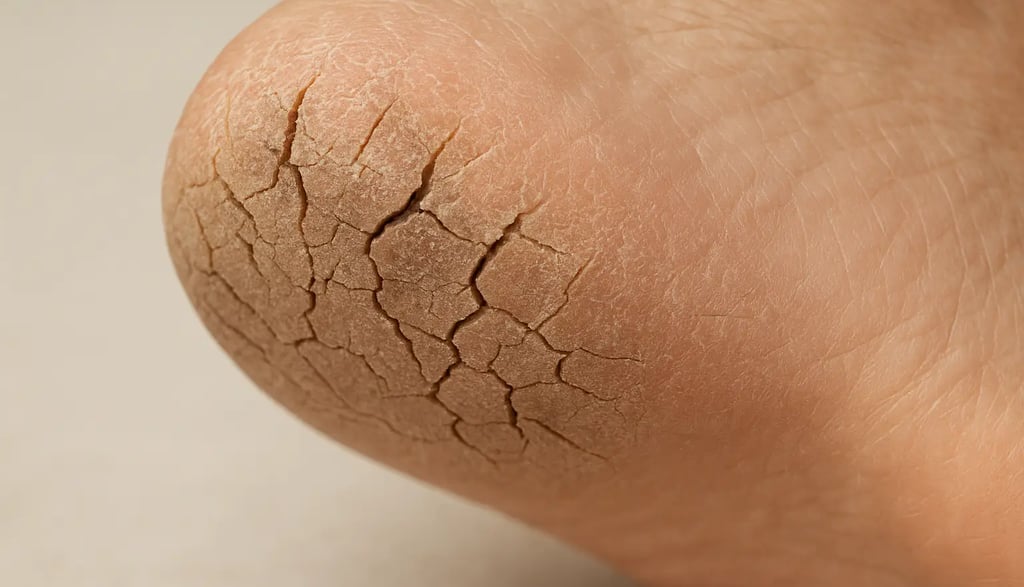Cracked Heels: Causes, Effective Remedies, Prevention Tips & When to See a Doctor
Discover what causes cracked heels, how to treat them at home, proven remedies, prevention tips, and signs you should see a doctor. Keep your feet soft, smooth, and healthy year-round.


What Causes Cracked Heels?
Cracked heels, also called fissured heels, are a common foot problem that can result from both internal health issues and external environmental factors. Knowing the exact causes is the first step toward prevention and treatment.
How to care for dry, cracked heels
Internal Causes of Cracked Heels
Certain medical conditions can make your feet more vulnerable:
Diabetes: Poor blood circulation and reduced foot sensation increase the risk of dryness and cracks.
Hypothyroidism: Reduced thyroid activity can cause low skin hydration, leading to dryness and fissures.
Obesity: Excess body weight puts more pressure on the heels, stretching the skin and causing cracks.
External Causes of Cracked Heels
Lifestyle and environmental factors also contribute:
Dry Weather: Low humidity reduces skin elasticity, causing heel cracks.
Prolonged Water Exposure: Standing in water for long periods softens the skin, making it prone to damage when dry.
Improper Footwear: Shoes without proper support or with open backs increase heel friction and strain.
Effective Remedies for Cracked Heels
If you’re wondering how to heal cracked heels fast, both home remedies and professional treatments can help.
Home Remedies for Cracked Heels
Coconut Oil: Deeply hydrates dry skin; apply before bed and wear cotton socks.
Shea Butter: Rich in fatty acids, nourishes and repairs skin. Massage daily for softer heels.
Honey Soak: Add honey to warm water, soak feet for 20 minutes, rinse, and moisturize.
Professional Treatments
Exfoliation: Use a pumice stone or foot scrub to remove dead skin.
Specialized Foot Creams: Products with urea or salicylic acid soften tough skin and lock in moisture.
Prevention Strategies for Cracked Heels
To avoid cracked heels in the future, follow these foot care tips:
Maintain Foot Hygiene: Wash feet daily with mild soap, dry thoroughly (especially between toes).
Wear Supportive Footwear: Choose cushioned shoes with proper arch support; avoid thin soles or high heels.
Moisturize Daily: Use a thick cream with glycerin or urea after washing and before bed.
Follow a Skin-Healthy Diet: Include vitamin E, omega-3 fatty acids, and zinc from nuts, seeds, fish, and vegetables.
When to See a Doctor for Cracked Heels
While most cases are mild, some symptoms indicate a need for medical care:
Deep, Bleeding Cracks: These increase the risk of bacterial infections.
Signs of Infection: Redness, swelling, warmth, or pus around the cracks.
Persistent Pain: Could signal other foot problems like plantar fasciitis.
Diabetic Foot Concerns: People with diabetes should monitor foot health closely and seek early treatment.
Frequently asked questions
Q1: What is the fastest way to heal cracked heels?
A: The fastest way is to exfoliate dead skin, apply a thick moisturizer with urea or glycerin, and wear cotton socks overnight to lock in moisture.
Q2: Are cracked heels a sign of a health problem?
A: Sometimes, yes. Conditions like diabetes, hypothyroidism, or obesity can make you more prone to cracked heels.
Q3: Can Vaseline cure cracked heels?
A: Yes, petroleum jelly like Vaseline can help seal moisture in the skin, but it works best when combined with exfoliation and proper hydration.
Q4: How can I prevent cracked heels naturally?
A: Wear cushioned shoes, moisturize daily, avoid prolonged water exposure, and eat a diet rich in vitamin E, omega-3 fatty acids, and zinc.
Q5: When should I see a doctor for cracked heels?
A: Seek medical advice if you have deep bleeding cracks, signs of infection, persistent pain, or if you have diabetes and notice changes in foot skin.
